Emma-Jane Houghton is the commercial director leading the government’s hospital construction programme. She tells Jordan Marshall how she is hoping to encourage a broad range of suppliers on to the project and foster greater diversity of thought. Portraits by Tom Campbell
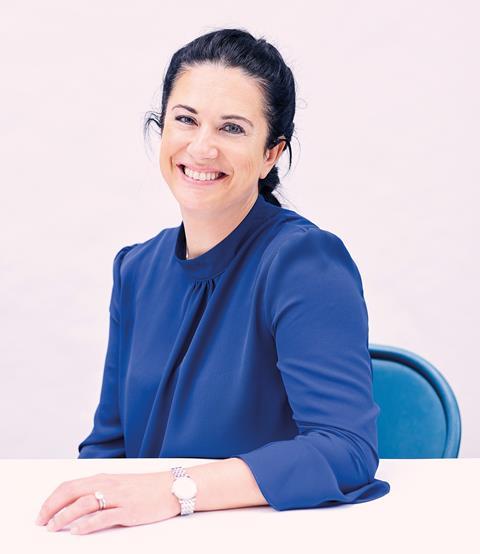
“I really am here to make it happen, and that means being prepared to fall out with people sometimes. You have got to be brave and bold about how you advocate for what we should be doing – and that doesn’t mean going along with the status quo most of the time.”
New Hospital Programme (NHP) commercial director Emma-Jane Houghton knows what she wants and she knows what she needs to do to make it happen.
The woman picked to lead the commercial strategy for the government’s decade-long hospital building programme – which will see 40 hospitals built across England by 2030 – is aware of the huge task in front of both her team as a client and the construction industry that is going to have to deliver it. Overall the programme consists of 48 hospitals, eight of which are active projects which Houghton’s team has inherited in flight.
The scale of the NHP provides a significant opportunity for companies of all sizes across a broad range of sectors to make a long-term investment in their capability and skills base, creating jobs and driving growth
Emma-Jane Houghton
Talking to Houghton, it’s clear she is excited about the challenge for herself but animated too by the opportunities for construction, an industry that, she says, is “close to my heart”.
“The scale of the NHP provides a significant opportunity for companies of all sizes, across a broad range of sectors, to make a long-term investment in their capability and skills base, creating jobs and driving growth,” she says.
Presented with a monumental task, Houghton – who was born and raised in Lancashire – has developed a unique commercial approach that will see the client and supply chain entwined more closely perhaps than ever before. So, what has brought her to this point in her career, what does her commercial plan need construction firms to do differently, and how is the sector going to get these projects built?
Mix of skills
“I want to combine the best of what I have got as a QS – my creativity from music, my management consultancy background, and my relationships and network – to really make this [NHP] happen,” she says.
This highlights how Houghton’s approach is perhaps reflective of her route into construction, which was anything but typical. An arts graduate with dreams of becoming a concert pianist, she concedes that she “didn’t even know what the construction industry was” when she first joined it shortly after graduating from Keele University in 2001.
“I graduated and realised I needed a job, so I think I was very, very lucky that I fell into construction. I have always felt that it’s a very, very diverse industry where people are prepared to invest in people around them and train them up,” she says. “It’s a fantastic work environment that not enough people know about.”

Her foray into construction became a career, with Houghton, who is now based in Surrey, going on to train as a chartered quantity surveyor, working first at Mott MacDonald and then at Turner & Townsend. This gave way to a role as an associate director at big-four consultancy firm KPMG, before making the transition into client roles with Heathrow Airport.
“I think, if you’re not always from a traditional background with a sort of fixed idea about what construction is, you can develop a broad range of skills that you then bring to fruition in a role like I am in now,” says Houghton. “I’ve got a project and major programme delivery background. I am a chartered quantity surveyor with all the technical training that goes with it, but I am also a trained big-four management consultant and I am able to bring that mix of skills to be effective in the role I’ve got now.
Emma-Jane Houghton’s CV
Houghton finds herself leading one of the country’s biggest social infrastructure programmes, which makes her a powerful person to know. Described as “fiery, passionate and forthright” by some in the sector who have met her, Houghton is known as a specialist in commercial strategy.

Having completed her first degree in English and music at Keele University in 2001, she went on to train as a chartered quantity surveyor, working first at Mott MacDonald and then at Turner & Townsend. She made a rapid rise through commercial advisory and construction delivery roles.
Highlights of her career so far include working for Heathrow Terminal 5, the East London Line extension, KPMG and Heathrow’s expansion, where she was commercial delivery director responsible for procurement, contracts and supplier management.
Since January 2021 she has been with the Cabinet Office and is the commercial director for the New Hospital Programme. She also worked on the development of the Construction Innovation Hub’s Value Toolkit and holds a number of other roles on major construction schemes and programmes.
She chairs the Crossrail 2 expert cost, commercial and risk group and the Institution of Civil Engineers’ civil engineer of the future working group, Engineering Rebellion.
Houghton holds the rank of major in the engineering and logistics staff corps commissioned to provide impartial and confidential advice to the British Armed Forces.
She speaks with a level of surety that instils confidence in her ability to deliver the project and deliver it on her terms – and she is quite clear about what those are. “It’s about thinking about what I’m actually buying, maybe I’m also buying a person with a skill, maybe I’m buying a bit of intellectual property,” Houghton says.
“Maybe I should be thinking about some digital solution. Maybe I’m buying something to be automated. I’m buying an outcome rather than an input.”
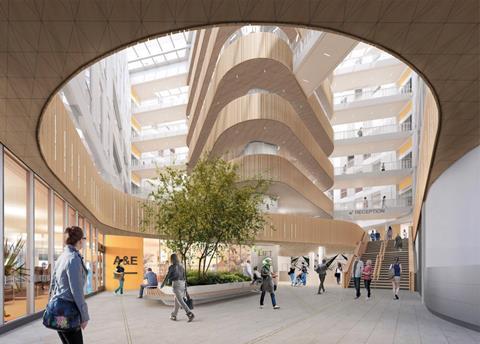
And this idea is at the heart of the NHP, which is being delivered via a framework alliance with industry, the hope being that the supply chain can be set up horizontally. This means that every level of the chain will be feeding back into the client more often and that the “collective learnings” can be applied across the programme.
> Also read: Market overview on healthcare
“It is a generational alliance, which we are calling Gen A … From a company perspective that means they have got a pipeline, they can invest now and think, ‘while there might not be a role tomorrow, there probably is work for me if I get my act together in a couple of years’ time’.”
Over time Houghton says that the framework alliance will allow a broad range of suppliers to become involved in the NHP and that programme benefits, such as net zero design and the use of MMC, will be achieved as suppliers will have been invested in and have a visible pipeline of work. She adds: “To begin with, the trusts will be the contracting authorities, but we will have our framework alliance in place for them to use.”

Houghton flags up how in this way the NHP will intertwine two pieces of sector-wide policy that she has been central to developing – the Construction Innovation Hub’s Value Toolkit and the government’s Construction Playbook. Both of these instruments promote the use of standardisation and MMC, the importance of introducing design for manufacture and assembly (DfMA) at the earliest stage possible and, in the case of the latter particularly, the way in which net zero policy must be baked into a project’s planning from the outset.
“We are working to ensure SMEs have visibility and access to opportunities, and will put proactive measures in place so that we engage SMEs and make sure they provide feedback into our emerging package and procurement strategies,” she says.
The procurement process
While Houghton is driving the commercial strategy and its delivery, she has a wider team working with her – particularly now in the early procurement process. This is where Vanessa Bold, head of supplier management, enters the picture.
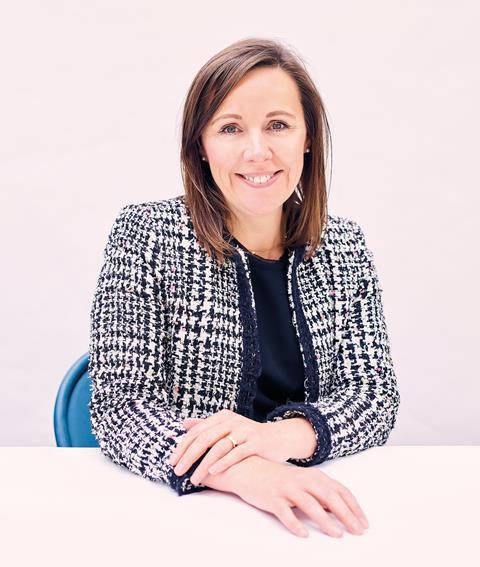
Early engagement is integral to shaping how the programme will progress, says Bold, (pictured), adding that the New Hospital Programme (NHP) has received feedback from almost 800 construction organisations in its first month of conversations with the industry.
“We’ve engaged with well over 400 organisations that signed up to our smart survey, which is absolutely brilliant for us. We’re really excited by the energy that has produced and that all of those organisations want to engage with us further down the line,” she says.
“But also we have spoken at our launch event with Build UK. We followed that up with an event with Actuate UK, where we engaged with the MEP market specifically, and we’ve also done a talk with Build Offsite. Between those three events, we have now spoken to about 390 organisations.”
There are a number of pieces of work already up for grabs, with the NHP’s client-side commercial partner role already in the process of being procured – submissions for the role are now being considered. The team has started discussions about its programme design and delivery partner, having engaged with the market towards the end of last month.
“We are in talks with regards to the emerging procurement strategy for that,” Bold says. “We’ve issued a market sounding briefing and questionnaire to industry. We’re looking forward to feedback from the market to form our emerging approach. We’ll use that feedback to shape our final procurement plan before we go to market.”
In terms of actively procuring contractors and other industry specialists, Bold and Houghton say that a timeline has not yet been set. They want to ensure they have the programme set up correctly and the commercial strategy can be refined to work in the thoughts of industry.
Bold says: “From the outset we think it is imperative we are taking that market intelligence to validate our approach and know that we’ve got it right.”
Diversity
One of the goals of the programme is to create a hospitals playbook, a blueprint for both the design and delivery of the hospital of the future which will then be owned by the alliance. And, for this to occur, Houghton says construction must be prepared to innovate and look to draw inspiration and ideas from a different source.
“Most definitely, we should be casting a net much wider at that academia level and at that apprenticeship level. And not just for young people but also for people who are quite mid‑career and going into a second career.
“We should be much more accommodating to bringing in that range of skills. What you really want is that diversity of thought, rather than ‘groupthink’, otherwise you’re never going to get the innovation you really need.”
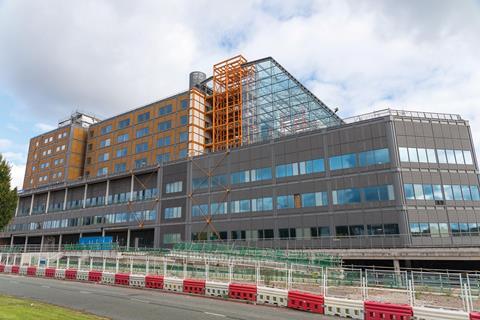
After a pause she adds that it’s a no-brainer for the industry to embrace a more diverse workforce – not least because, if it doesn’t, it’s “knackered, because so much of the workforce is ageing”.
As Houghton seems ritually to do, she is practising what she preaches. The NHP programme team is 50% made up of women. Asked if she feels her role as a woman leading a major government social infrastructure programme is significant to highlighting career pathways, Houghton has a number of thoughts.
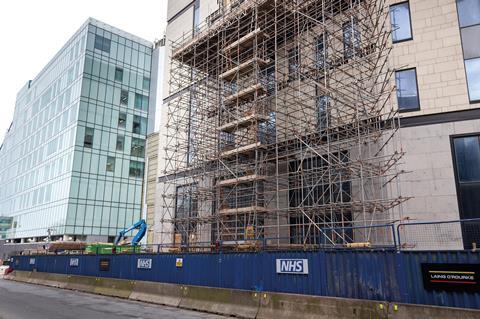
“I have never felt that being female in this industry has held me back at all. I’ll go as far as to say that, in the breadth of my experience, I find the construction industry to be the least sexist environment I’ve ever worked in, actually.
“I have never felt that I’ve particularly needed female leadership in order to get ahead, and in fact I have had enormous investment from a handful of really significant to me, male mentors, and that has been fantastic.”
But she concedes that she is fully aware this is not the universal experience and that, if she can play a role in supporting not only other women but other people from non-traditional construction backgrounds, that is something she wants to do. “I’m often told, as a senior woman, that for other women, and for other people who are less like the norm … it gives them confidence and makes a big difference. And I take that seriously.”
As she speaks of her experience, her passion and genuine affection for the construction sector are clear. She speaks of the “generosity of time” that exists within its workforce, but she also recognises the limitations in the current way that it operates.
Houghton says she is acutely aware of the roles that risk transfer and a lack of historic investment in innovation due to uneven workloads and fragmentation play. She says her team is putting a lot of thought into creating a commercial model that fosters an environment that breaks down these historic challenges.
We want to bring in sensible risk allocation. lots of clients are guilty of not doing that, and it puts suppliers off, which creates a really weak market
Emma-Jane Houghton
“If they [construction firms] can see it, they can start investing in that forward pipeline and we can start to talk about some of the sorts of innovation and modern methods of construction that we aim for further down the line.
“When it comes to things like sustainable contracting practices, it’s a commitment to creating what I call a safe contracting environment for all of these suppliers. We want to bring in sensible risk allocation. Lots of clients are guilty of not doing that, and it puts suppliers off, which creates a really weak market. We want big, strong markets from which we can draw, so why wouldn’t we create that environment?”
She adds that latent manufacturing capability within the sector at the moment is quite low, with confidence in some of these technologies – particularly as they link to componentisation and design standardisation – being a bit ad hoc, which constitutes another major challenge for a sector charged with delivering 40 hospitals using MMC.
“I see it as our job to create that safe contracting environment, create that space and that infrastructure for it to happen, by first and foremost making a commitment to digital BIM level 4, driving that design standardisation.”
Houghton is clear on the task in front of her and what needs to be done, but is acutely aware that construction, as a traditional industry, may have some fragments that don’t want to play ball.
To those firms she has one thing to say: “We need collaboration. So, for our part, we’re going to have to really foster the safe contracting environment that makes that possible. We’re going to need to create the contracts and environment that gives the incentive for that to happen. We’re going to have to be ruthless with companies and behaviours that don’t accord with that and make it a potentially toxic environment.”
So, is it safe to say there isn’t anything that she would rather be doing? “This is just my absolute dream job,” Houghton says. “It’s commercial. That’s what I’ve trained in; that’s what I’m really good at. It’s about building hospitals for the next generation. It’s about net zero carbon and it’s about all of those things that matter for communities, matter for patients, matter for the nation.”
A stable background
Houghton may have her hands full with a 10-year, 40-hospital construction programme but she has obvious passions away from the sector. “I’m mad about horses. I’ve been mad about horses ever since I was little, so I do a bit of eventing,” she says.
Eventing is where horse and rider compete in three disciplines – show jumping, dressage and cross-country – but Houghton says her equine passion is about much more than the competition. It is both a community and a chance to be alone with her thoughts. “It’s just about being down in the yard and being around horses and other people who are horse mad. It’s a social thing as much as it is a sport. It’s a sport, and it’s a hobby, and it’s a lifestyle all at the same time.
“I’m just as happy being down the yard on a Sunday, going for some hack and just being on my own for a couple of hours as I am getting ready for a competition.”
Houghton has taken the passion even further in the past 12 months – breeding her first foal from her best eventing mare, a horse for which she has high hopes. “I’m not a breeder by any stretch of the imagination but that has been a really interesting experience – to breed a foal that I hope is going to go round Badminton one day, probably not with me, but with a professional rider.”
The Badminton Horse Trials is a five-day event, one of only six annual Concours Complet International Five Star events as classified by the Fédération Équestre Internationale. It takes place in April or May each year in the park of Badminton House, the seat of the Duke of Beaufort in south Gloucestershire, England.
Given Houghton’s work ethic and attitude, it seems very likely that this foal will one day be tackling that famous course.




























No comments yet